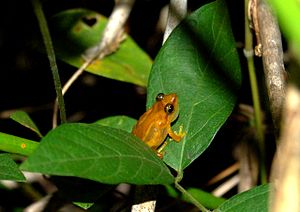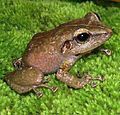Difference between revisions of "AY Honors/Coquí/Answer Key"
m |
(+ some Coquí answers) |
||
| Line 14: | Line 14: | ||
==1. To what class does the coquí belong?== <!--T:2--> | ==1. To what class does the coquí belong?== <!--T:2--> | ||
| + | Amphibia | ||
==2. This class is divided into three orders, Apoda, Caudata, and Anura. The coquí belongs to the Anura order. What other members belong to this order?== <!--T:3--> | ==2. This class is divided into three orders, Apoda, Caudata, and Anura. The coquí belongs to the Anura order. What other members belong to this order?== <!--T:3--> | ||
| + | Frogs and toads. | ||
==3. What member of this class is mentioned in the Bible?== <!--T:4--> | ==3. What member of this class is mentioned in the Bible?== <!--T:4--> | ||
| + | Frogs are mentioned in the Bible, more famously as one of the 10 plagues against the Egyptians, found in [https://www.biblegateway.com/passage/?search=exodus+8%3A2-13&version=NKJV Exodus chapter 8]. They are also mentioned in [https://www.biblegateway.com/passage/?search=psalms+105%3A30&version=NKJV Psalms 105:30]; and [https://www.biblegateway.com/passage/?search=Revelation+16%3A13&version=NKJV Revelation 16:13]. | ||
==4. Give the general traits of this class.== <!--T:5--> | ==4. Give the general traits of this class.== <!--T:5--> | ||
| + | They are cold-blooded; their skin is not covered with anything; they are soft and moist (with the exception of [[w:Caecilian]], which have small scales); they have an aquatic larval stage of development; the young generally undergo metamorphosis from larva with gills to an adult air-breathing form with lungs; they use their skin as a secondary respiratory surface. | ||
==5. What characteristics distinguish the coquí from the rest of the amphibians?== <!--T:6--> | ==5. What characteristics distinguish the coquí from the rest of the amphibians?== <!--T:6--> | ||
| + | An absence of an inter-digital membrane (which means they're not adapted to swimming); the last toe ends in a T shape; it has terrestrial reproduction and direct development, which means they have no tadpole stage, they hatch from eggs as fully formed small frogs. | ||
==6. Why is it call the coquí?== <!--T:7--> | ==6. Why is it call the coquí?== <!--T:7--> | ||
| + | The species is named for the loud call the males make at night. | ||
==7. What other sound, song, or call, besides "coquí", does the coquí make?== <!--T:8--> | ==7. What other sound, song, or call, besides "coquí", does the coquí make?== <!--T:8--> | ||
| + | Different coquí make different types of sounds, such as: | ||
| + | "Churi- ki – ki – ki", [[w:Red-eyed_coqui|Red-eyed coquí]] (''Eleutherodactylus antillensis''), locally known as coquí churí<br /><br /> | ||
| + | {{#widget:YouTube|id=-Kg6F8E0B24}} | ||
| + | |||
| + | "Tic – tic – tic", [[w:Grass_coqui|Grass coquí]] (''Eleutherodactylus brittoni'')<br /><br /> | ||
| + | {{#widget:YouTube|id=O_7RndpknfY}} | ||
| + | |||
| + | "Clicks – clicks", [[w:Eneida%27s_coqu%C3%AD|Eneida's coquí]] (''Eleutherodactylus eneidae)'')<br /><br /> | ||
| + | {{#widget:YouTube|id=cIxQMx9ykec}} | ||
| + | |||
| + | Prolonged and fine whistle, [[w:Whistling_coqui|Whistling coquí]]<br /><br /> | ||
| + | {{#widget:YouTube|id=3qWbIBrLOC0}} | ||
| + | |||
| + | A low "chip – chip", [[w:Bronze_coqui|Bronze coquí]], or Richmond's coquí, (''Eleutherodactylus richmondi'')<br /><br /> | ||
| + | {{#widget:YouTube|id=RvYUfI01tj4}} | ||
| + | |||
| + | Waterdrops falling, [[w:Mona_coqui|Mona coquí]] (''Eleutherodactylus monensis'')<br /><br /> | ||
| + | {{#widget:YouTube|id=L8cfyPym9sc}} | ||
| + | |||
| + | "Tuit – tuit – tuit", [[w:Golden_coqu%C3%AD|Golden coquí]] (''Eleutherodactylus jasperi'')<br /><br /> | ||
| + | {{#widget:YouTube|id=hLo8rqnb2ME}} | ||
==8. What is the purpose of the song of the coquí?== <!--T:9--> | ==8. What is the purpose of the song of the coquí?== <!--T:9--> | ||
| + | This sound serves two purposes; "CO" serves to repel males and establish territory, while the "KEE" serves to attract females. | ||
==9. What is the genus of the species of the Puerto Rican coquí? Give the name of five species and show slides or pictures of them.== <!--T:10--> | ==9. What is the genus of the species of the Puerto Rican coquí? Give the name of five species and show slides or pictures of them.== <!--T:10--> | ||
| Line 36: | Line 64: | ||
===a. is the largest?=== <!--T:13--> | ===a. is the largest?=== <!--T:13--> | ||
| + | The [[w:Web-footed_coqu%C3%AD|web-footed coquí]] (''Eleutherodactylus karlschmidti'') (also known as Karl's robber frog).<br /> | ||
| + | [[File:5-web-footed coqui.jpg|thumb|left|5-web-footed coquí|alt=5-web-footed coquí]] | ||
===b. is the smallest?=== <!--T:14--> | ===b. is the smallest?=== <!--T:14--> | ||
| + | The [[w:Plains_coqui|Plains coquí]] (''Eleutherodactylus juanariveroi'') | ||
| + | [[File:CoquiLlanero.jpg|thumb|left|Coquí llanero|alt=Coquí llanero]] | ||
| + | {{clear}} | ||
===c. sings "coquí?"=== <!--T:15--> | ===c. sings "coquí?"=== <!--T:15--> | ||
| + | <gallery> | ||
| + | File:Common Coquí.jpg|Common coquí (''Eleutherodactylus coqui'') | ||
| + | File:Female guajon frog on tree.jpg|Puerto Rican rock frog (also known as Puerto Rican cave-dwelling frog or rock coquí), locally known as the coquí guajón (''Eleutherodactylus cooki'') | ||
| + | File:Eleutherodactylus portoricensis.jpg|Mountain coquí, (also known as upland coquí, Puerto Rican robber frog) (''Eleutherodactylus portoricensis'') | ||
| + | File:Eleutherodactylus wightmanae.jpg|Melodious coquí (''Eleutherodactylus wightmanae'') | ||
| + | </gallery> | ||
===d. has a song similar to the sound of a water drop?=== <!--T:16--> | ===d. has a song similar to the sound of a water drop?=== <!--T:16--> | ||
| + | The [[w:Mona_coqui|Mona coquí]] (''Eleutherodactylus monensis'')<br /><br /> | ||
| + | {{#widget:YouTube|id=L8cfyPym9sc}} | ||
===e. has a song similar to the sound of winding a watch or passing fingernails through the teeth of a comb?=== <!--T:17--> | ===e. has a song similar to the sound of winding a watch or passing fingernails through the teeth of a comb?=== <!--T:17--> | ||
===f. has a color considered black or dark marble?=== <!--T:18--> | ===f. has a color considered black or dark marble?=== <!--T:18--> | ||
| + | The [[w:Web-footed_coqu%C3%AD|web-footed coquí]] (''Eleutherodactylus karlschmidti'') (also known as Karl's robber frog).<br /> | ||
| + | [[File:5-web-footed coqui.jpg|thumb|left|5-web-footed coquí|alt=5-web-footed coquí]] | ||
| + | {{clear}} | ||
===g. has the highest frequency of vocalization?=== <!--T:19--> | ===g. has the highest frequency of vocalization?=== <!--T:19--> | ||
| + | The [[w:Plains_coqui|Plains coquí]] (''Eleutherodactylus juanariveroi'') | ||
| + | [[File:CoquiLlanero.jpg|thumb|left|Coquí llanero|alt=Coquí llanero]] | ||
| + | {{clear}} | ||
==12. In what part of the world is the coquí considered a plague and how did it arrive there?== <!--T:20--> | ==12. In what part of the world is the coquí considered a plague and how did it arrive there?== <!--T:20--> | ||
Revision as of 17:52, 16 March 2018
1. To what class does the coquí belong?
Amphibia
2. This class is divided into three orders, Apoda, Caudata, and Anura. The coquí belongs to the Anura order. What other members belong to this order?
Frogs and toads.
3. What member of this class is mentioned in the Bible?
Frogs are mentioned in the Bible, more famously as one of the 10 plagues against the Egyptians, found in Exodus chapter 8. They are also mentioned in Psalms 105:30; and Revelation 16:13.
4. Give the general traits of this class.
They are cold-blooded; their skin is not covered with anything; they are soft and moist (with the exception of w:Caecilian, which have small scales); they have an aquatic larval stage of development; the young generally undergo metamorphosis from larva with gills to an adult air-breathing form with lungs; they use their skin as a secondary respiratory surface.
5. What characteristics distinguish the coquí from the rest of the amphibians?
An absence of an inter-digital membrane (which means they're not adapted to swimming); the last toe ends in a T shape; it has terrestrial reproduction and direct development, which means they have no tadpole stage, they hatch from eggs as fully formed small frogs.
6. Why is it call the coquí?
The species is named for the loud call the males make at night.
7. What other sound, song, or call, besides "coquí", does the coquí make?
Different coquí make different types of sounds, such as:
"Churi- ki – ki – ki", Red-eyed coquí (Eleutherodactylus antillensis), locally known as coquí churí
"Tic – tic – tic", Grass coquí (Eleutherodactylus brittoni)
"Clicks – clicks", Eneida's coquí (Eleutherodactylus eneidae))
Prolonged and fine whistle, Whistling coquí
A low "chip – chip", Bronze coquí, or Richmond's coquí, (Eleutherodactylus richmondi)
Waterdrops falling, Mona coquí (Eleutherodactylus monensis)
"Tuit – tuit – tuit", Golden coquí (Eleutherodactylus jasperi)
8. What is the purpose of the song of the coquí?
This sound serves two purposes; "CO" serves to repel males and establish territory, while the "KEE" serves to attract females.
9. What is the genus of the species of the Puerto Rican coquí? Give the name of five species and show slides or pictures of them.
10. In what other countries, outside of Puerto Rico, is the coquí found?
11. Which coquí:
a. is the largest?
The web-footed coquí (Eleutherodactylus karlschmidti) (also known as Karl's robber frog).
b. is the smallest?
The Plains coquí (Eleutherodactylus juanariveroi)
c. sings "coquí?"
- Eleutherodactylus portoricensis.jpg
Mountain coquí, (also known as upland coquí, Puerto Rican robber frog) (Eleutherodactylus portoricensis)
- Eleutherodactylus wightmanae.jpg
Melodious coquí (Eleutherodactylus wightmanae)
d. has a song similar to the sound of a water drop?
The Mona coquí (Eleutherodactylus monensis)
e. has a song similar to the sound of winding a watch or passing fingernails through the teeth of a comb?
f. has a color considered black or dark marble?
The web-footed coquí (Eleutherodactylus karlschmidti) (also known as Karl's robber frog).
g. has the highest frequency of vocalization?
The Plains coquí (Eleutherodactylus juanariveroi)



